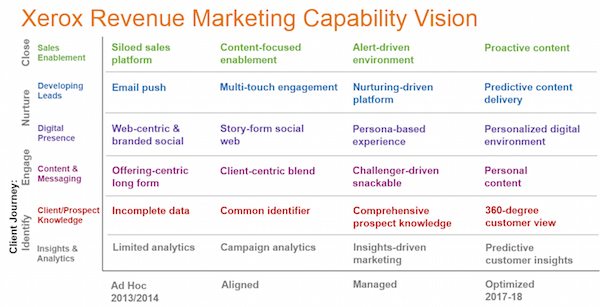At the Online Marketing Summit here in Boston last week, I caught up with Steven Woods, co-founder and CTO of Eloqua.
I’ve been a fan of Steven’s since his first book on the transformation of sales and marketing, Digital Body Language. He now has a new book — Revenue Engine: Why Revenue Performance Management is the Next Frontier of Competitive Advantage — that continues this discussion on the new marketing.
So I took advantage of our rendezvous to ask him a few questions…
What makes this new marketing different?
According to Steven, we’re on the tail end of a decade long transformation of buyers owning access to sales information, controlling their destiny in the sales process. A buyer can go where they want, at any point in the so-called sales lifecycle — ask a question on Quora, follow accounts on Twitter, chat with friends on Facebook, visit your web site, your competitors’ web sites, read an analyst’s blog, a customer’s blog, etc. Buyers decide what they want, when, and from whom.
“Where you need to be to interact with buyers is not in marketing’s control,” insists Steven. “You have to be where the buyers go.”
The overwhelming difficulty with that today, however, is that there has been an explosion in the number of outposts where buyers go. “This can be a little chaotic,” Steven admits. “But we have one advantage. Because so many of these outposts are digital, we can instrument what the buyer does, who they are, what they interact with.”
In Steven’s view, what makes marketing so different today isn’t just the number of new outposts or the operational challenges that presents. Says Steven, “The new part of today’s marketing is bringing all those pieces of insights on the buyers together.“
“So many of the individual clues are small — really small,” he points out. Any one follow on Twitter or visit on your web site doesn’t — and shouldn’t — register on marketing’s Richter scale. “Any one thing does not a buyer maker. They’re only relevant in the aggregate.”
Digital Body Language was about buyers moving online. Revenue Engine is about harnessing the digital clues of those buyers in aggregate.
What does this aggregate view look like?
Although a linear pipeline — the classic sales/marketing funnel — doesn’t perfectly define reality for any one prospect, it continues to be a pretty good model for managing the flow of prospects to customers in aggregate.
“It’s important to look at the overall funnel,” says Steven. “From early-stage marketing to late-stage selling.”
According to Steven, there are five dimensions of this funnel that are important to understand:
1. Value. “What is the economic value in the funnel right now, from earliest stage of awareness through education and investment? How big is that total pipeline, even 6 or 8 quarters out, and how big is each stage?”
2. Reach. “At each stage of the funnel, how many folks — not the size of the deal, which is the value metric above — am I able to engage? This is about uncovering where the choke points are, identifying gaps.”
3. Conversion. “What percentage make it from one stage of the funnel to the next? What are the fall off points?”
4. Velocity. “The speed at which deals move through the stages of the pipeline — but specifically the speed from each stage to the next, identifying the points of slowdown. Each one can be affected with different levers, but you need to understand the metrics before you apply the lever.”
5. Return. “Dollars in, dollars out — how efficient is this total pipeline?”
Steven believes that this total pipeline, with these dimensions transparently in view, is the key to sales and marketing alignment. “Sales people see one quarter out from their pipeline. Marketing generally sees not the current quarter, but two or three quarters out. The challenge is tying those two things together into a unified view with a longer time horizon and understanding the process governing that flow.
This shared, holistic view enables better conversations and coordination between sales and marketing. “Fuzzier things that marketing used to say, such as, ‘We need to do some branding,'” explains Steven, “Now means, ‘We need broader reach at the earliest end of the funnel.’ Organizations can have intelligent discussions about branding. ‘We’re in tough economic times, so we can cut back on branding now, but we will take a hit 6 quarters out.'”
What is the role of software, technology in this transformation?
“The technical challenge of modern marketing is that explosion of smaller touchpoints,” replied Steven. “The marketing team is tasked with understanding all of these touchpoints, but each individual touch point is too small to care about. You can’t put the human effort to personally respond, ‘Oh, look, a Facebook fan!'”
“Marketing must aggregate these touchpoints — they’re small, but relevant in aggregate. Such aggregate analysis can only be done with technology. Minimalist technology, such as Excel spreadsheets, is not sufficient to tease out the insight.”
But are marketing departments ready to manage such technology?
“It’s a hard transition, but marketing departments have been wrestling with this transformation for 10 years,” notes Steven. “In the last two years, it has become the norm. Marketing operations, marketing processes, the analytics — this technology is now the norm.”
Do marketers need a different set of skills for this?
“You need people in place who are a little better about numbers, metrics, analytics, operations — all of the little details that need to be mapped out on a whiteboard, such as figuring out the exceptions when buyers jump in and out of your pipeline. This is less of a creative discipline, more of an analytic discipline.
What about the IT department?
“The group that is having to reinvent itself more than marketing is IT,” remarks Steven. “IT, historically, was all about servers, networks, wiring, software patches. Now with SaaS, that wiring challenge has been placed back on the vendor. Forward-leaning IT organizations are now taking on the ‘whiteboarding challenge’ — understanding the data, how we’re going to track things, how these five or six systems are going to talk to each other.”
“Quite technical marketers or business-savvy IT folks, comfortable talking line of business — you’ll see organizations structured both ways.”
Thanks, Steven!





Good interview Steve, hope to see you at Dreamforce!
Thanks for posting this Scott – Stevens book is a great step up for people from the islands of thinking and activity/tools that have been the hall mark of this space for the last few years. Interestingly, and in line with many of your other blogs, we’ve found even CEOs today want to bypass both marketing and IT to secure their own views on what is happening in their revenue engine – we’ve great traction with BI systems linking iterative forecasts to marketing metrics from tools like Eloqua, then into SFC/Dealmaker – and the general ledger. Reasonable revenue forecast and actuals ten quarters out. Steven is right, THIS is the future – but a cloud app with little or no IT involvement.